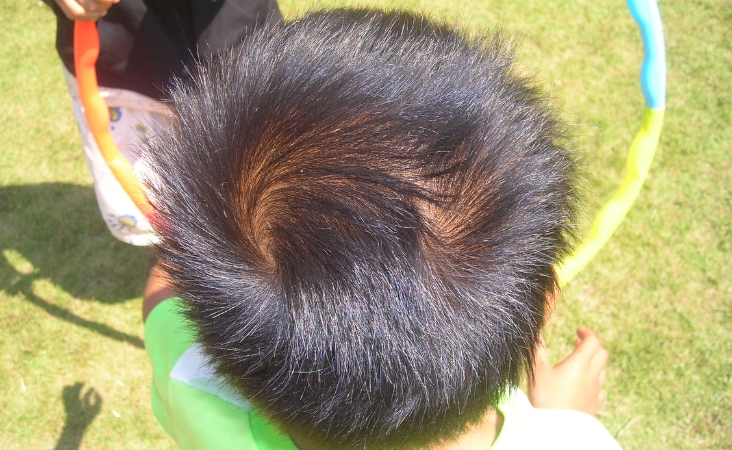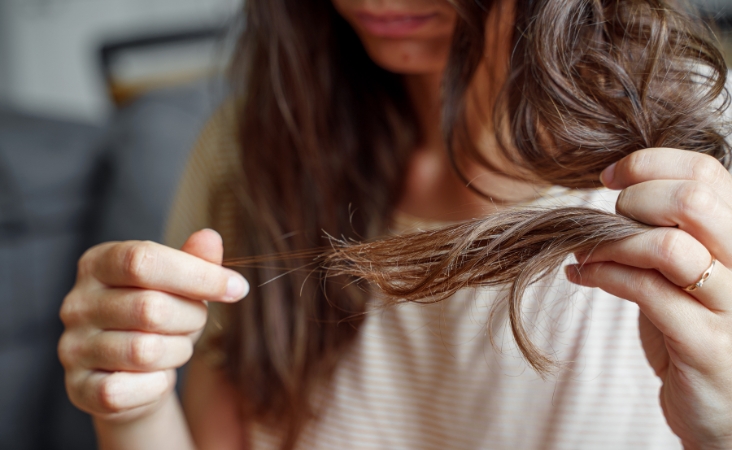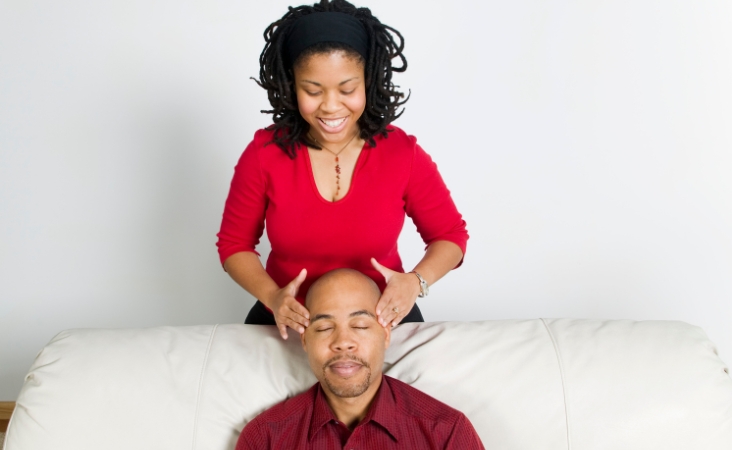Cowlick or Balding? Know the Differences and Recover in 2024
- Written by Victor Lordhair
- Mar 2, 2023
- |
- 15 min read
 Listen to the full text
Listen to the full text
Have you ever dealt with a part of your hair that sticks out like a sore thumb and won’t respond no matter what you do with a comb? If yes, it’s probably a cowlick. Many young males and females consider it to be a sign of baldness. But is it really true? Is there a connection between cowlick and baldness?
In this blog, Lordhair will settle the ‘balding vs. cowlick’ debate once and for all. We will also share a list of treatments to deal with both conditions.
Let’s first understand what exactly cowlick means!
What Is a Cowlick?
A cowlick is a tuft of hair that grows in a different direction than the rest of your strands on the scalp. The result of a natural whorl on the head, it has a spiral pattern of hair growth and is usually spotted either at the crown of the head or near the hairline. However, scientists believe that it can occur anywhere on the scalp.
You would be surprised to know that around 5% of the population have two hair whorls (double crowns)! Known to be less noticeable among men and women with longer hair, a lot of men and women have one cowlick.

What Exactly Does Balding Mean?
As the word itself suggests, it’s a condition where a person loses hair from their scalp or any other part of the body where hair would normally grow. Men say they are balding when hair follicles begin to shrink. The hair keeps getting thinner and thinner to a point where it eventually just stops growing altogether.
Also called hair loss and thinning, it can be caused by a variety of factors including genetics, age, hormonal changes, medical conditions, or certain medications.
Cowlicks vs. Balding: Key Differences
Since cowlicks disrupt hair flow and make it harder for men and women to style their hair, most people think of it as a sign of hair loss. But the truth is that it isn't! Cowlicks differ from a bald spot in several ways:
-
Hair growth pattern: The very obvious difference that one could notice between a cowlick and a bald spot is the pattern. In cowlicks, there’s still significant growth of strands in the affected area. It’s just that a tuft of hair grows in a different direction from the surrounding hair. However, in baldness, the hair becomes increasingly sparse or absent.
-
Location: As we said earlier, cowlicks are generally located at two particular areas of the scalp - the crown and the hairline. In case you are balding, the ‘spot’ can appear anywhere on the scalp. A lot of us find bald spots on the frontal region, mid-scalp, vertex transition zone, and crown. In fact, baldness and thinning may also affect other parts of the body where hair normally grows.
-
Rate of progression: We simply couldn’t leave out this point in the cowlick vs. balding debate. When it comes to progression, cowlicks are known to be typically a permanent feature of a person’s hair growth pattern and do not worsen over time. On the contrary, baldness progresses over a period of time, resulting in more extensive hair loss.
-
Hair texture: Cowlicks don’t typically affect the texture of hair. They just simply change the direction of the hair tuft. However, baldness can cause changes in hair texture. It can make the hair thinner and less dense.
For instance, in male pattern baldness (MPB), the hair on the crown and top of the head becomes shorter, finer, and less pigmented. In female pattern baldness (FPB), hair becomes less dense with a wider parting line.
7 reasons and the best solutions to fix hair growth that has stopped on the head
What Causes a Cowlick?
We hope that it is now clear that there’s no connection between cowlicks and balding. But what exactly causes the whorl to appear on the scalp? According to scientists, our hair grows in three directions - forward, backward, or to the side. Sometimes, a smattering of hair follicles doesn’t get the message and begins to grow in the opposite direction from the rest of the hair.
As a result, hair strands coming out of those follicles start to grow at a different angle, causing cowlicks to form on the scalp. Anyone can have a cowlick. If your parents or grandparents have hair whorls on their heads, you are more likely to have one as well.
What Are the Early Signs of Balding?
We talked about the reasons behind a balding head among men and women in the beginning. However, there are some signs that may help in identifying the condition and taking remedial action:
#1 Thinning hair
Thinning hair in one spot or all over could be one of the first signs of balding in males and females. Hair strands on the scalp gradually become thinner, weaker, and less dense. Thinning may take place on the top or front of the scalp at first because hair is most prone to miniaturization in these areas.
As time passes, the hair follicles may shrink and produce finer, shorter hair on the remaining areas of the scalp as well.

#2 Receding hairline
Has your hairline started to creep back over your temples, forming an M-shape? Consider it as another sign of balding. Commonly found in males, one may notice thinning hair around the hairline, on top of their scalp, or in the whorl at the back of their head.
#3 Excessive hair shedding
We all lose 50 to 100 strands a day. However, if your scalp seems to be shedding more hair than usual during activities such as washing, and brushing, or you keep finding hair on the pillow, it is a sign of approaching baldness. Excessive shedding occurs when the hair follicles become weaker and produce finer, shorter strands that are more prone to falling out.
#4 Widening part
A widening part is another early sign of balding. It’s commonly seen in individuals with longer hair and is fairly prominent in women. The scalp becomes more visible through the hair as hair loss progresses, causing the part to appear wider than it used to. This is often a result of the thinning of hair follicles which can no longer cover the scalp as effectively as before.
People with a widening part usually need to adjust their hair part to conceal the specific area. Dermatologists suggest that it can be a serious indicator of further heavy hair loss to come.
#5 Miniaturization
For those who don’t know, miniaturization refers to the process where individual hair strands become finer and thinner over a specific period of time. In the early balding stage, hair follicles gradually produce thinner and weaker hair shafts which lead to less dense hair.
However, as miniaturization progresses, these follicles may eventually stop growing altogether, contributing to overall hair loss. This phenomenon is often the result of hormonal changes and genetic predisposition.
Ever wondered if bald men are attractive to women? Here’s the answer!
Other Early Signs of Balding
In addition to the above-listed signs of baldness and aggressive damage, here are some more early indicators of balding:
-
Itching or burning scalp
-
Dandruff or flakes
-
Changes in hair texture
What Are Some Treatments for Cowlicks and Balding?
Sadly, there’s no treatment for dealing with cowlick as it is simply a natural hair growth pattern one is born with. Although males and females have tried to remove their natural whorl using laser hair treatment, they were unable to eliminate it completely because the hair follicles are placed in such a manner that they can’t be repositioned. Plus, there is no need to feel bad about a cowlick since the biggest film stars have one too. Balding celebrities are also more common than you think.
While that’s the story of cowlicks, there are several treatments available to stop baldness from getting worse. Here are a few:
-
Medications: Medications can help in slowing down or stopping hair loss and promote hair growth. While some disrupt the conversion of testosterone to dihydrotestosterone (DHT) - a hormone that contributes to hair loss, others increase blood flow in hair follicles which promotes hair growth.
-
Hair systems: Unlike medications, hair replacement systems have zero side effects. Also known by the name of men’s hairpieces, toupees, hair wigs, or toppers, these are designed using real human hair hand-woven onto a base made of premium skin-friendly materials.
Hair systems will not only conceal the bald spots on the scalp but will also provide the opportunity to color and style hair any way you want.
Browse the complete Lordhair collection of the best hair replacement systems and hair wigs for women!
-
Scalp massage: Yes, you read it right! The natural remedy used by our grannies for making hair smooth and shiny can also help in fixing baldness and promoting hair growth. Regular scalp massage promotes blood flow to the hair follicles, thereby encouraging hair growth.
Lordhair recommends using nourishing oils such as coconut or argan oil during the massage to restore hair growth on the affected areas of the scalp.

Cowlicks vs. Balding: Endnote
There you go! We have told you everything about cowlicks and balding. Whether you have a bald spot or a cowlick, there are ways you can learn to manage them better. Although it is true that dealing with hair loss can be a bit more stressful, men as well as women can take control of their hair health and feel confident and comfortable in their appearance by being informed and taking timely measures.
Got any queries? Send them to support@lordhair.com and have them answered by our hair experts.
Also read:
- The connection between high cholesterol and hair loss explained
- Everything about double crown hair
- Useful tips to reactivate hair follicles
- Tips to prevent hair loss while fasting
- Everything covered about a disturbed hair-shedding cycle
Check out these fresh product pages as well:
- Shop hairpieces for thinning hair
- The best partial hairpieces for receding hairlines are right here
- Shop wigs for alopecia at the best discounts


